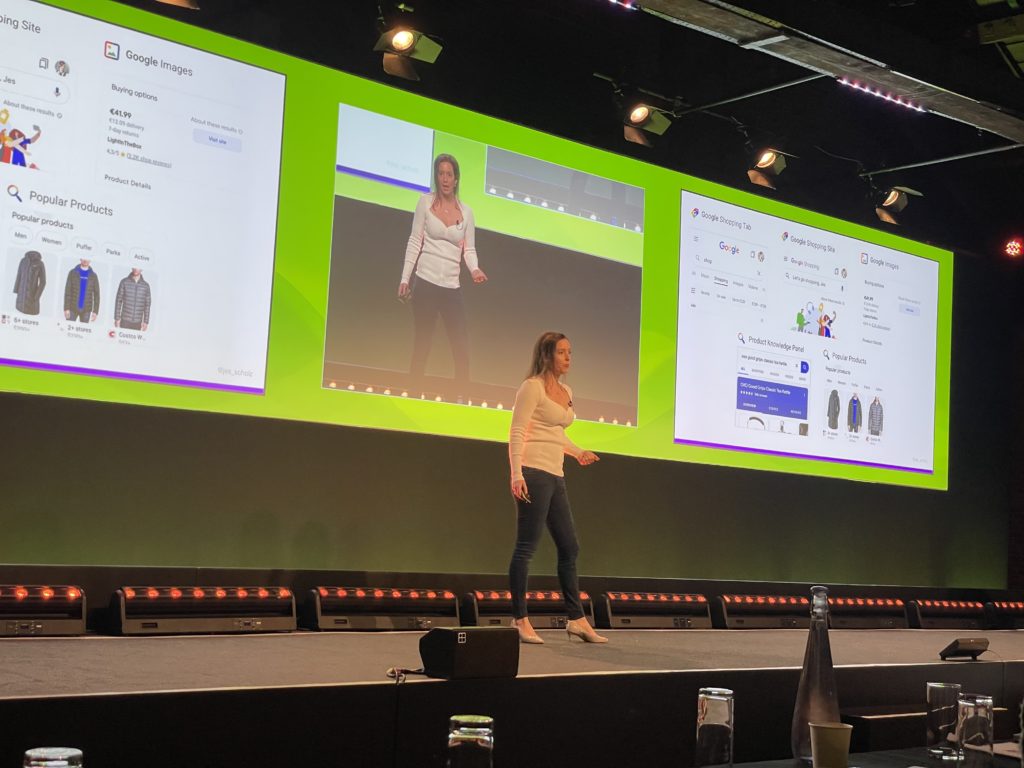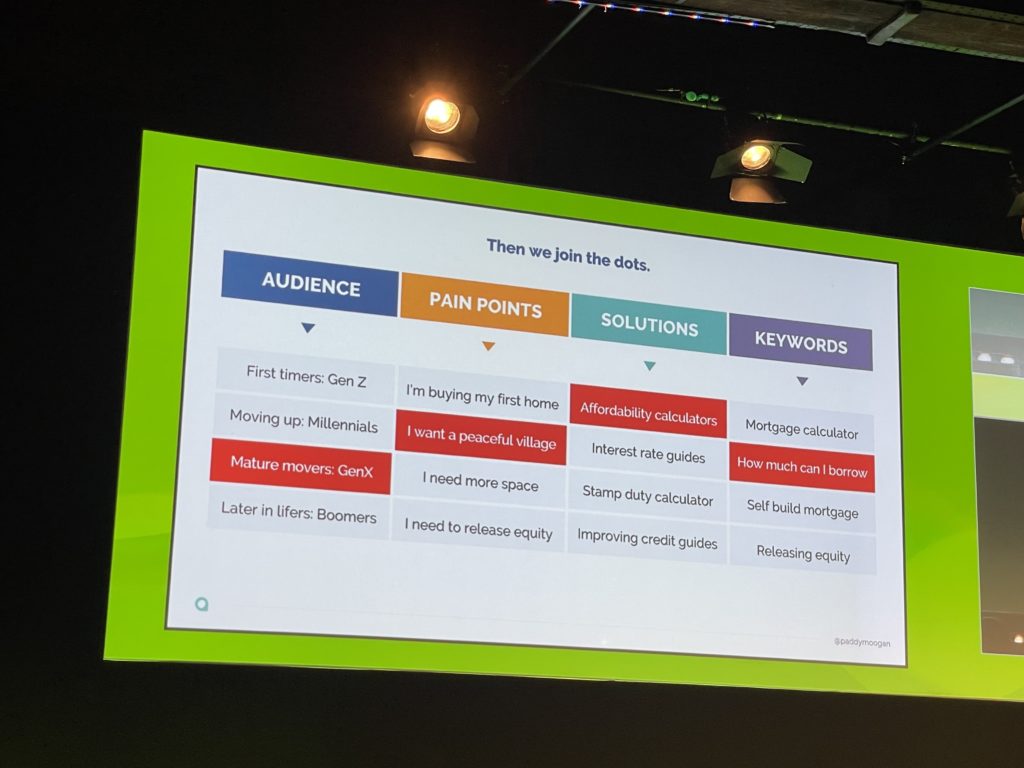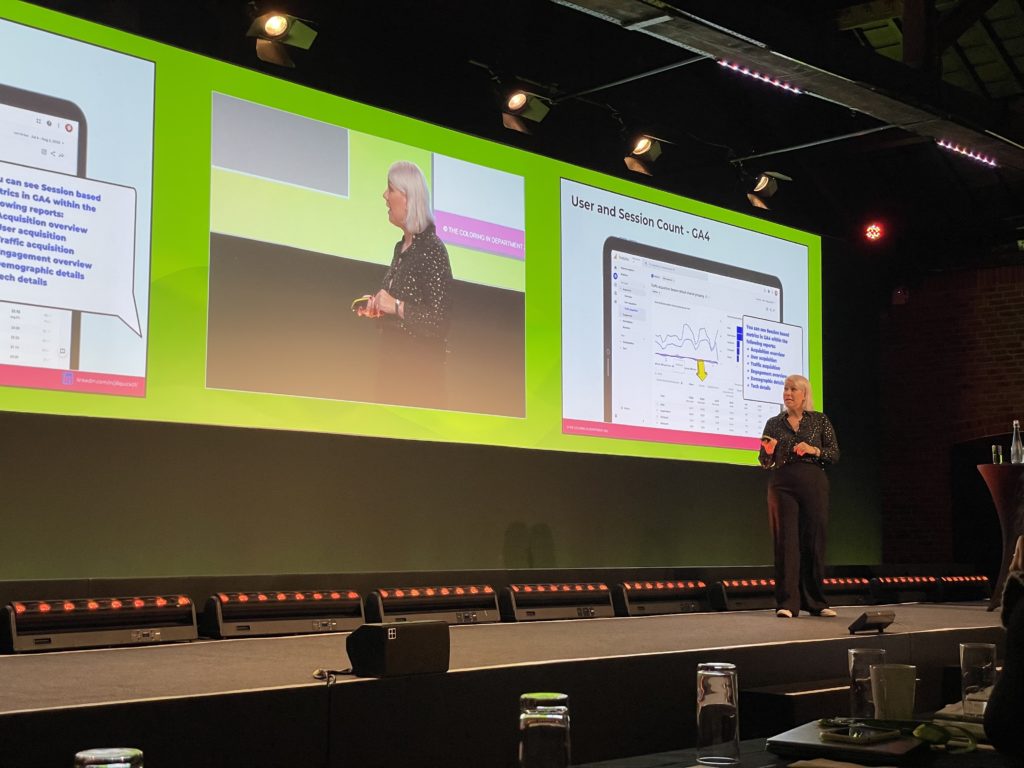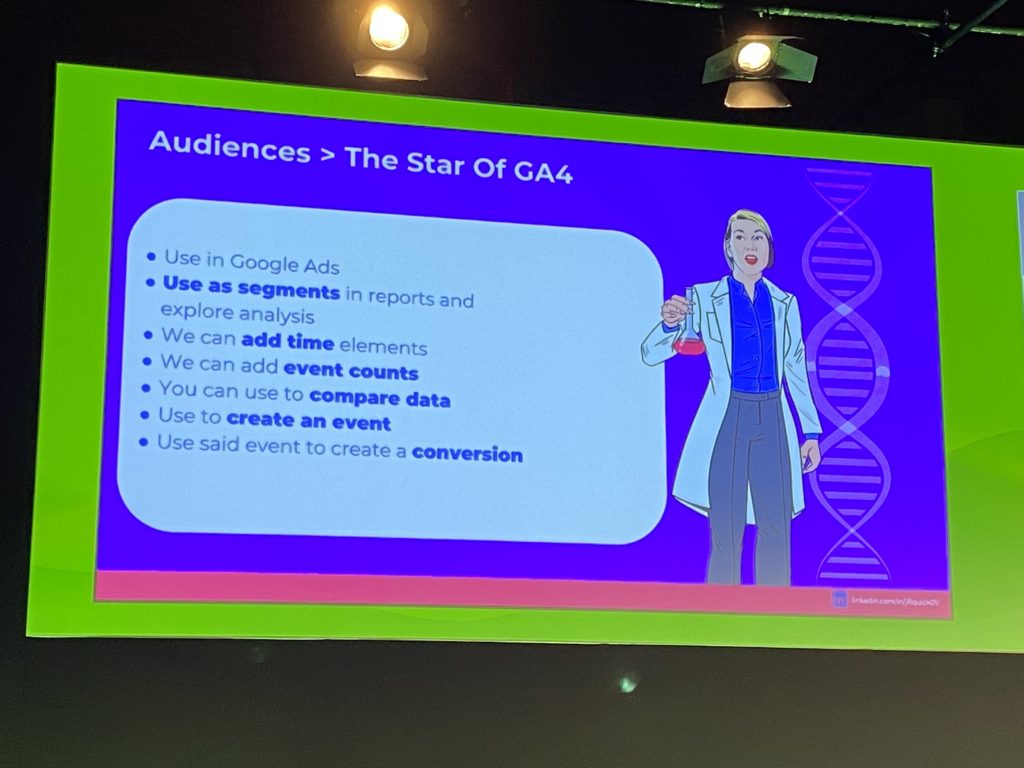From Apple’s upcoming ‘search’ engine to lessons learned from GA4 migrations: this year’s SearchLove Conference was packed with fresh insight. Couldn’t make it? No sweat. Our SEO specialists were out in force and have distilled their key takeaways into this handy blog.
StrategiQ x SearchLove 2022 – Day 1
Jes Scholz – Group CMO, Ringier – Google is not (only) a Search Engine @jes_scholz
The ‘all new’ GA4 won’t fix SEO reporting for marketers. In fact, Google Analytics is undervaluing your work as an SEO, which is more than just driving clicks, it’s driving conversions.
Google is pushing image search really hard at the moment and image searches are becoming a key source of sessions as a content discovery platform. Alongside that, Google is News Category pages by fulfilling user-intent within the search results.
Google may be moving to remove the purpose of Ecommerce websites entirely, by trying to aggregate users into their own ecosystem experiences of shopping. They want to catch and keep customers in their ‘walled garden’ for longer, changing the conversion path and locking brands out until the end and to get into more google experiences, ‘Deep Pages’ are where true user value lies. If content creators can figure out how to master the eco system, they’ll be winning.
Google will continue to evolve and invade, so act now. As an evolving eco system for experience, and up against other big tech players including Meta and Microsoft, content creators are starting to lose control, which is why the focus must remain on the value to the end user first.

Paddy Moogan – Aira – The Future of Link Building: What got us here won’t get us there
Link building should focus on the sweet spot between building links you don’t ask for creating strong referenceable technical content. Wider topics and themes get more links if they have broader appeal. A focus on vitality makes it easier to get more links.
Google may not care about content relevance, but it’s imperative to look for existing link worthy content and opportunities for internal linking.
Most importantly, always align to your client’s KPIs, not your own measure of success for SEO.

Jill Quick – The Coloring in Department – GA, But not as you know it: How to use GA4 to get the most out of your strategies


GA4 uses a different data model – event based, which means a new session isn’t created when the source or medium updates mid-session. GA4 is becoming better at preventing bot spam through the requirement to have an API secret, which blocks unauthorised spam traffic through the measurement protocol.
There are five types of GA events:
- Automatically collected – page_location, first_visit
- Enhanced Measurement – click, file_download
- Bundled in with the data stream
- Recommended – purchase, sign_up (pre-defined list of event names for standard tracking)
- Custom
One idea is to use values to quantify events tracked and show the value to the client. Creating events from events using the parameter matching can enable us to create specific events to be marked as a conversion.
BigQuery linking is available for free which enables us to access all of the raw data behind GA4 – SQL is used to query. Google has a sample data set for BigQuery but remember, it’s important to change from a 60 day history.
GA4 has exploration reports that allow retroactive analysis. Funnels allow us to build up a view of how users progress through a website using custom steps. Flexible parameters allow detailed funnels through.
Elapsed time for funnels helps to understand how users are progressing through the funnels.
Path Analysis is another handy exploration that allows us to interrogate user journeys from both a start or an end point.
Tom Anthony – SearchPilot – The future of search: Exploring Apple’s upcoming ‘search’ engine
Apple has a history of ‘invading’ an established market inline with their marketing strapline ‘think differently’. Whether the iPod or the iPhone, they’ve disrupted established markets and impenetrable brands. In mid 2020 rumours started appearing that Apple were working on building their own search engine. Robert Scobe back in May 28 – revealed something could emerge as early as January 2023.
There are four key differences between Apple & Google Search. Google pay Apple to be the default search engine. But may stop paying soon – antitrust cases against Google being the default. Siri suggested websites in iOS 14 is a sneak peak – powered by Apple’s own web index. Also, Apple publish ranking factors that have a strong alignment with what the existing ranking factors are for Google, and Apple already has knowledge elements – called Siri Knowledge.
Four things we reckon Apple Search will do:
- Beyond the web – Apple’s search engine could be using a federated search approach – delegating to multiple providers and then aggregating. Apps have been built to handle the different types of intent that could allow for this – allowing web + app blended. iOS search results are returned as a blended set of data – where it’s the relevancy that matters. This would help Apple to bypass the advantage Google has.
- No Blue Links – Apple could use custom snippets that provide results/actions outside of the apps on a search screen. A good example of this is the new widgets and live activities. App Clips – small parts of an app that are streamed to your device that allows interaction briefly. Designed to allow you to complete a small task, and mobile native results that could allow immediate action.
- Private personalisation – Apple’s machine learning (ML) is purely device based, where Google is all cloud based. Apple is privacy centric. Currently, Apple is using a differential privacy to track interaction – it groups trends together but it is not possible to identify individual trends. Results could be ordered and personalised using the on device ML. Federated search would allow for fully authenticated personal search and we anticipate that Apple will champion a ‘private, yet personalised’ mantra. Fully personalised search experiences in a way that Google cannot do.
- Advertising – will Apple sell ads? Yes, Apple are already running ads on the App store and app clips are an opportunity for Apps to run a free snippet of a paid app.
Carrie Rose – Rise at Seven – 5 ways SEO can be much more short term through reactive marketing
There are two types of people: opinion formers and opinion followers. If you can get the opinion formers in your industry to advocate your brand, you will influence your target customers in a more intuitive way.
If you already rank 1 for a keyword, one way of driving more traffic via search is to create more demand.
Big brands like John Lewis create demand for keywords during their Christmas ads, but they don’t rank in search for them.
30% of people use site search and those people are more likely to convert on average.
Glimpse is a great tool for overlaying search volumes onto Google trends. You can also set up alerts for certain keywords (10 free per month)
Lily Ray – Amsive Digital – The aftermath of all the helpful content update, the September 2022 Core update & the product review updates
The Helpful Content Update (HCU) means that if your website is hit with the penalty – it will affect your entire domain and lower rankings across the board, not just with the unhelpful content flagged. The HCU is a negative ranking signal, not a positive one, so it is primarily sites that are being published rather than sites being rewarded for being helpful.
HCU Sites have content from other sites, are littered with loads of ads and deceptive pop-ups and download buttons.
Product Reviews Updates
‘Express expert knowledge about products where appropriate is the key advice from. They look for evidence such as visuals, audio and photos to re-enforce the authenticity of a review. Google is pushing for tangible evidence you have the product. Danny Sullivan from Google says it’s a page-to-page level update, so doesn’t affect the whole domain if a page is suspect.
Users demand evidence with product reviews, and there are two sites as examples of how to do it well -‘Clever Hiker’ and ‘Switch Back Travel’ who have photos of the products in use on the content itself. Wirecutter by the New York Times are best to consult with best in class Product reviews that show rigorous testing and evidence.
September Core Update
Search intent – Google is getting way better at understanding intent. So when we are hit by a core update, always start by booking at the intent of who outranks you.
News sites have been hit hard in the US and UK. Metro, Daily Mail and the Mirror in the UK all lost out – but the main theory is that less news is being shown in the SERPS.
Danny Sullivan from Google confirmed that HCU is completely separate to Core Updates and therefore sites can be hit for just one or both.
Be everywhere, images, videos, discover, merchant centre, web stories. Cover every intent for your content strategy. If you want to rank for ‘dogs’ you need to cover all intent for Dogs at an umbrella level.
StrategiQ x SearchLove 2022 – Day 2
Algorithm Updates – Brownian Noise – Tom Capper – Moz
Moz data shows increasing turbulence within SERP movements. We’re now regularly seeing well above Panda 4.0 fluctuations.
So what are Google’s incentives for algorithms?
- KPIs – Google’s constantly testing to see what impact changes have
- Refreshing – resetting the rankings to unlock new opportunities for brands
It is unlikely that these updates are deliberately to cause confusion, but it helps to understand the different types and how to gear content accordingly.
What is a core update? There are two types of update; specific and vague.
Specific will look at CWV, mobile first indexing and types of ranking factor. Specific updates are often slow whilst Google builds data. Vague updates will deliver warnings of flux, but limited advice about how to interpret them.
Remember: algorithms will be both positive and negative
Building topics – in phases
Phase 1: Client goals – what’s the target? Who’s the ideal customer? What is most profitable? What is a conversion worth? When? How? Where? What questions are tied to a conversion? What is the sales process and how can content support it?
Phase 2: Gathering data – not forgetting that we only know what Google shows us. Some relationships are shown using Knowledgegraph Search API, autocomplete, keyword planner & Google Trends. Wikipedia is key resource and makes up 67% of the knowledge panels.
The process:
Gather your data > Remove irrelevant terms > Enrich with keyword metrics > Get more data [human curation is key]
Phase 3: Analyse data -using visualisations to work with the data. Compiling various data sets together
Phase 4: Create topics that: align to goals, high search volume, have conversion intent and play into the hands of the terms we can rank for and build internal links related to the queries.
Building a resilient global SEO strategy in the face of economic headwinds in 2022 and beyond – Jake Roman-Capon – Brainlabs
- 40% of global businesses suffer with reduced sales and revenue during a recession.
- In a recession the biggest opportunities lie in the lowest and highest value products.
- In a recession taking advantage of your natural peaks and seasons is so important.
- When budgets are cut, Agree on quarterly cadence to protect performance and allow 3 monthly increments to demonstrate value.
Petra Kis-Herczegh – Yext – Things I learned from sales teams that every SEO should know
Assess, and re-assess your maturity
Organisational maturity for a business needs to contain high culture, efficiency, strategy and technology. This maturity chart helps businesses score and measure how SEO fits in the business environment.
Conducting a maturity analysis should not be a one time task. Utilise the insights to inform the SEO strategy and return on a regular basis to update the analysis.
Collaborate, always
Each different stage needs a different, dedicated strategy. Teams make better decisions than individuals, and need to ensure SEO strategies aren’t run by one team member. Teams with a high level of diversity make better decisions than individuals – 87% likelihood. SEO cannot succeed without cross-functional team collaboration
Show the value
Stories can help us to explain the need for an SEO change/development/strategy to C suite. The goal of communication is to increase understanding, not get them to agree with you. Focus your communication with the client on the outcome, not the detail. Add probability as a metric alongside impact & effort.
Will Critchlow – SearchPilot – Moneyball is the future of SEO
SEO Analytics Revolution
Using testing to tie SEO changes to actual results. Doing so allows us to cut out the low percentage improvements – cutting out the untested site changes.
SEO Testing functions best with high traffic & scale sites.
Taking a section of pages, defining a variant set and control set. Pages should be as similar as possible for a fair test. Testing page splits and not user splits can be much more effective and actionable. What’s more, SEO testing allows us to use actual data to interrogate and understand ranking factor
SEO Tactics Search Pilot has uncovered at scale with their clients:
- Negative Factors – JS display dependency causes 6% lower performance.
- Pre rending AngularJS that was being rendered correctly was neutral.
- Improve UX with a more responsive JS front-end.
- Testing where JS is involved can cause an unpleasant mix of your hypothesis and testing Google’s capability of rendering JS
- UX is growing in importance – smaller interstitials showed better performance than a full screen variant.
- Hidden content is still a big deal. Google have said hidden content i.e. in accordions is fine, but TrustPilot have data that suggests removing accordions and having just visible text, gives a positive uplift in visibility.
- SEOs focus more on the ranking rather than the CTR of the SERP result itself unlike within Paid Search.
- Structured Data can move the needle. If you can get a rich snippet that your competitors don’t have, you can get an uplift in performance.
- Internal links have shown positive rates of improvement when an increased amount has been tested
- Testing AI copywriting can and has worked in the past for businesses. It cannot satisfy every copywriting objective.
- HTML priority ordering is still showing surprising results, i.e. moving the block of body content higher up above the sidebar.
- Tests between algorithms are leading indicators that you’re on the right track; only test good, solid hypotheses; go back and re-test factors around significant algorithm changes.
- Modern on site SEO should cut out untested changes.
About the SearchLove Conference
Organised by Distilled, SearchLove draws a prestigious speaker lineup, covering the role of search in content, data, paid, PR and more. This year’s conference takes place over two locations – starting in London (17-18th October) before moving to San Diego on 13-14th March next year.


















